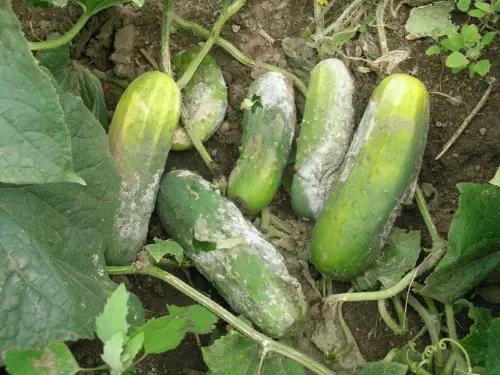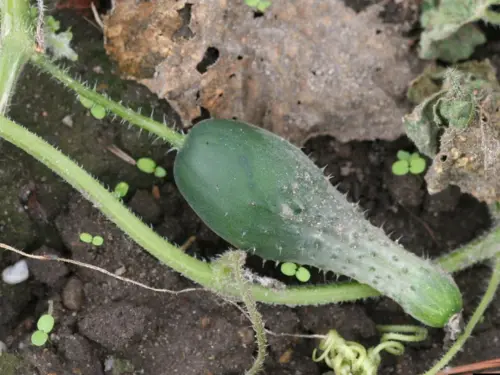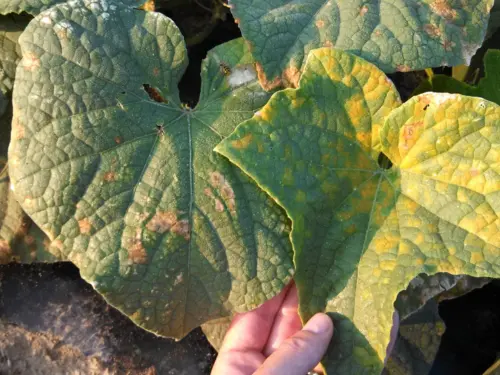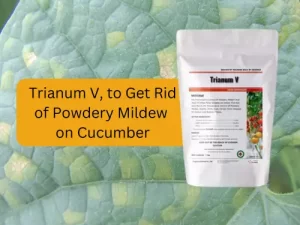Downy mildew cucumber is a serious disease. You must have seen symptoms coming up on your lower leaf surface if this disease is starting to eat up your cucumber plantation.
You can get rid of downy mildew on cucumber by using biological products such as Trianum V.
What causes mildew on cucumbers? It is caused by fungal organisms like Pseudoperonospora cubensis. This organism is an obligate parasite that needs plants like cucurbit to grow well and survive. It needs plant debris to grow, and it eats up the whole cucumber plantation. Infections develop very quickly in moderate temperatures, humid climates, and on cold nights.

Early stage downy mildew cucumber diseases are characterized by a series of distinctive symptoms and early signs that can help in its early detection and management. Initially, the upper surfaces of downy mildew cucumber leaves develop small, yellowish spots, which may appear angular due to being confined by the leaf veins. As the infection progresses, these spots can coalesce and turn brown.
On the underside of the leaves, a hallmark sign is the presence of a grayish to purplish downy growth, which is the fungal sporulation. This growth is most visible in the early morning or under moist conditions. Infected leaves eventually become necrotic and brittle, leading to defoliation.
Downy mildew cucumber is very strong in impacting the plantation. This disease has hampered a lot of fields full of cucumbers. If you are someone who is constantly doing cucumber plantation, then this is the part you should go through so that you can avoid such circumstances.
Environmental Hurdles
Downy mildew in cucumber is known to thrive in cold conditions and also in wet conditions with moderate to high humidity. If there is cold and humid weather with a bit of wetness in the environment then you are in trouble. Usually, the peak periods of such conditions are autumn or spring.

Overhead Irrigation
Are you watering cucumber plants with overhead irrigation? Well, then, you are in trouble. This irrigation system makes the complete environment highly suitable for downy mildew attacks. Drip irrigation is highly suitable as it keeps the wet conditions conducive for downy mildew out of the question as of now.
Poor Air Circulation Issues
It is absolutely true that cucumber plantations give amazing profits. You can churn money easily, but that does not mean you will keep a lot of cucumber plants with fewer gaps. The dense population of cucumber plants creates a microclimate that is very suitable for downy mildew to attack all the crops living there.
Infected Seeds or Transplants
People usually do not check the source of seeds or transplants at all. Downy mildew disease cycle can start from there too. As the infected seeds grow, these downy mildew symptoms start to be clearly visible and will eat all the other good cucumber plants too.

It is clearly said that prevention is better than cure, always! You can prefer the rotation of crops to have other varieties of crops, like legumes with cucumbers, to keep these pathogens away from your cucumber crops. You can also prefer downy mildew-resistant cucumber plants, which are usually hard to find. If you grab some varieties of resistant ones, then you will never need to worry about the loss of cucumbers at all. The most important thing that you should not miss is planting cucumber plants with proper gaps. Here are natural remedies for downy mildew:
Cucumber downy mildew is a severe disease, with cultural practices and monitoring as central components of control strategies. Cut and properly dispose of infected plant parts to help contain the spread of the downy mildew pathogen. Track yellow spots or angular lesions on leaves, especially the lower side, to detect downy mildew early. Early detection enables timely intervention, crucial for controlling the spread of downy mildew in cucumber plants. Change planting strategies, such as using resistant varieties, ensuring adequate spacing, and practicing crop rotation, for effective control. Combining these strategies improves plant conditions and minimizes the occurrence of downy mildew and other diseases.
Downy mildew treatment is quite simple. If you have basic ideas regarding the symptoms, you can straightaway start the counterattack against this horrible disease. There are a few methods to treat downy mildew and we will discuss this part of the post in detail.
Simple home gardening way
You can prune the parts of cucumber plants that are affected by downy mildew symptoms. You have to grab downy mildew symptoms very quickly so that you can start this simple downy mildew treatment. Downy mildew cucumber is a disease that spreads quickly, and that is why if you want to save money by avoiding fungicides, then you should be proactive while following this organic method. It is a simple cucumber downy mildew organic control.
Chemical treatment of downy mildew on cucumber
There are many chemical insecticides like K-Phite, Fungi-white, Prophyt, Revus, Quadris, and Ranman that are quite effective in attacking downy mildew issues. You can use them to combat the issues quickly, but it is a very short-term measure, as applying them can impact the environment heavily in the long run.
Biological treatment of using Trianum-V downy mildew fungicide
 This is the reason why biological treatment using the Trianum-V downy mildew, organic fungicides for downy mildew on cucumbers is effective in controlling diseases and is friendly to the natural environment. Biocontrol methods minimize downy mildew effects, ensuring future plant generations are not harmed by unhealthy soil. Novobac produces bio products for agriculture, including Trianum-V, recommended for controlling downy mildew effectively. This organic fungicide targets downy mildew, using Trichoderma harzianum powder as its powerful active ingredient. Trianum-V serves as a powerful weapon against downy mildew, providing an effective organic solution for farmers.
This is the reason why biological treatment using the Trianum-V downy mildew, organic fungicides for downy mildew on cucumbers is effective in controlling diseases and is friendly to the natural environment. Biocontrol methods minimize downy mildew effects, ensuring future plant generations are not harmed by unhealthy soil. Novobac produces bio products for agriculture, including Trianum-V, recommended for controlling downy mildew effectively. This organic fungicide targets downy mildew, using Trichoderma harzianum powder as its powerful active ingredient. Trianum-V serves as a powerful weapon against downy mildew, providing an effective organic solution for farmers.
Another famous fungicide is Trianum-V of Novobac, which works, or rather sings, ‘magic’ against downy mildew. Apart from being effective in treating the disease and its causative agents, it enhances healthier conditions in the soil. It is a formulation of Trichoderma harzianum in Trianum-V that develops a stable population of beneficial microorganisms around the plants’ root system, and promotes plant health growth.
Organic farms’ experiences with downy mildew offer practical concepts for alternate, sustainable disease control based on nominated maps. These farms practice integrated pest management (IPM) techniques, including cultural methods, biological methods, and organically accepted chemicals. For example, an organic farm reduced downy mildew incidence through crop rotation, compost for soil health, and resistant cucumber strains.
Neem oil and copper-based fungicides serve as efficient organic treatments for downy mildew control on these farms. These farms emphasize awareness and immediate action by removing infected plant materials to prevent downy mildew spread. By implementing comprehensive practices, organic farming controls downy mildew without synthetic chemicals, conserving the environment. For those asking, “How do you treat downy mildew on cucumbers?” the answer is Trianum-V. Frequent Trianum-V application improves cucumber plant care by increasing beneficial fungus support and protection.
Trianum-V retains a durable microbial population around cucumbers, enhancing overall plant health and resilience. Managing downy mildew with Trianum-V combines positive plant actions with eco-friendly agricultural practices. Organic farms’ experiences with downy mildew provide alternate, sustainable control concepts based on practical methods. These farms utilize integrated pest management techniques, including cultural methods, biological methods, and organic chemicals. For instance, one organic farm reduced downy mildew through crop rotation, compost for soil health, and resistant cucumber strains.
Neem oil and copper-based fungicides are efficient organic treatments for controlling downy mildew on these farms. Farms stress awareness and immediate action by eliminating infected plant materials to prevent the spread of downy mildew. Implementing comprehensive practices, organic farming demonstrates downy mildew control without synthetic chemicals, benefiting the environment.
Cutworms in gardens are a major menace to all..
As a farmer,I inspect my fields daily to monitor..
It all started with a worried farmer named Mr...

Leave a Reply